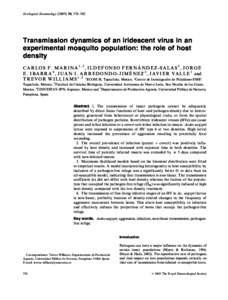Transmission dynamics of an iridescent virus in an
experimental mosquito population: the role of host
density.
Marina Fernández, Carlos F. y Fernández Salas, Ildefonso y Ibarra, Jorge E. y Arredondo Jiménez, Juan Ignacio y Valle, Javier y Williams, Trevor
(2005)
Transmission dynamics of an iridescent virus in an
experimental mosquito population: the role of host
density.
Ecological entomology, 30 (4).
pp. 376-382.
ISSN 0307-6946
![[img]](http://eprints.uanl.mx/1657/1.hassmallThumbnailVersion/Transmission_dynamics_of_an_iridescent_virus_in_an_experimental_mosquito_population_the_role_of_host_density.pdf)  Vista previa |
|
PDF
Transmission_dynamics_of_an_iridescent_virus_in_an_experimental_mosquito_population_the_role_of_host_density.pdf
Download (123kB)
| Vista previa
|
Resumen
1. The transmission of insect pathogens cannot be adequately described by direct linear functions of host and pathogen density due to heterogeneity generated from behavioural or physiological traits, or from the spatial distribution of pathogen particles. Invertebrate iridescent viruses (IIVs) can cause patent and lethal infection or a covert sub-lethal infection in insects. Aedes aegypti larvae were exposed to suspensions of IIV type 6 at two densities. High larval density increased the prevalence of aggression resulting in potentially fatal wounding.
2. The overall prevalence of infection (patent + covert) was positively influenced by host density and increased with exposure time in both densities. The survival time of patently infected insects was extended by ≈ 5 days compared with non-infected insects.
3. Maximum likelihood models based on the binomial distribution were fitted to empirical results. A model incorporating heterogeneity in host susceptibility by inclusion of a pathogen-free refuge was a significantly better fit to data than an all-susceptible model, indicating that transmission is non-linear. The transmission coefficient (υ) did not differ with host density whereas the faction of the population that occupied the pathogen-free refuge (ΠR) was significantly reduced at high host density compared with the low density treatment.
4. The transmission of free-living infective stages of an IIV in Ae. aegypti larvae is non-linear, probably because of density-related changes in the frequency of aggressive encounters between hosts. This alters host susceptibility to infection and effectively reduces the proportion of hosts that occupy the pathogen-free refuge.
| Tipo de elemento: |
Article
|
| Materias: |
?? QH301 ?? |
| Divisiones: |
Ciencias Biológicas |
| Usuario depositante: |
Admin Eprints
|
| Creadores: |
| Creador | Email | ORCID |
|---|
| Marina Fernández, Carlos F. | NO ESPECIFICADO | NO ESPECIFICADO | | Fernández Salas, Ildefonso | ifernand1@hotmail.com | NO ESPECIFICADO | | Ibarra, Jorge E. | NO ESPECIFICADO | NO ESPECIFICADO | | Arredondo Jiménez, Juan Ignacio | NO ESPECIFICADO | NO ESPECIFICADO | | Valle, Javier | | | NO ESPECIFICADO | | Williams, Trevor | NO ESPECIFICADO | NO ESPECIFICADO |
|
| Fecha del depósito: |
27 Ene 2011 21:48 |
| Última modificación: |
08 Feb 2016 22:40 |
| URI: |
http://eprints.uanl.mx/id/eprint/1657 |
Actions (login required)
 |
Ver elemento |


 Descargar estadísticas
Descargar estadísticas Descargar estadísticas
Descargar estadísticas

